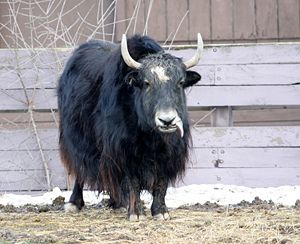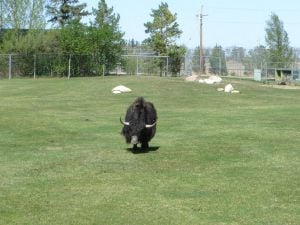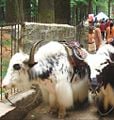Yak
| Yak | ||||||||||||||
|---|---|---|---|---|---|---|---|---|---|---|---|---|---|---|
 | ||||||||||||||
| Scientific classification | ||||||||||||||
| ||||||||||||||
| Bos grunniens Linnaeus, 1766 | ||||||||||||||
|
Poephagus grunniens |
Yak is the common name for a stocky, ox-like, bovine, Bos grunniens , of high-altitude Central Asian plateaus, characterized by long, upcurved, black horns and a long, shaggy coat of hair that reaches nearly to the ground. The wild population is small and restricted to parts of the Tibetan Plateau, generally ranging over 3,200 meters (10,000 ft) above sea level. However, there is a larger domestic population that extends to adjacent highlands and can be found throughout the Himalayan region of south Central Asia, the Qinghai-Tibetan Plateau and as far north as Mongolia. The scientific name Poephagus grunniens also is used, although this new name is not universally accepted.
domesticated over 4,000 years ago
importance
Overview
classification — bovine
description
name
adapted to high altitudes
In Tibetan, the word gyag refers only to the male of the species; a female is a dri or nak. In most languages which borrowed the word, including English, yak is usually used for both sexes.
Yaks are herd animals. Wild male yaks stand about 2–2.2 meters tall at the shoulder, the females about one third of that size, and domesticated yaks about 1.6–1.8 meters. Both types have long shaggy hair to insulate them from the cold. Wild yaks can be brown or black. Domesticated ones can also be white. Both males and females have horns.
- Notes: "The yak's latin name is Bos grunniens, from Bos meaning Ox, and Grunnio I grunt, hence grunniens, grunting - yaks are physically unable to low or moo like other cattle. The yak is a large, hairy, cow-like mammal native to Tibet. Its dark black-brown coat is dense, woolly, and extremely shaggy, though the colour can vary in domestic yaks" *h2g2 Yaks Edited Guide Entry
Domestic yaks mate in about September; the females may first conceive at about 3–4 years of age, calving April to June about every other or every third year, apparently depending upon food supply. This gestation period is approximately 9 months. In the absence of more data, wild animals are assumed to mirror this reproductive behavior. Calves will be weaned at one year and become independent shortly thereafter. Yaks may live to somewhat more than 20 years.
Wild yaks
Wild yaks (Tibetan: drong) can weigh up to 1,200 kg (2,400 lb) and have a head and body length of 3–3.4 meters. They usually form groups of between 10 and 30 animals. Their habitat is treeless uplands like hills, mountains and plateaus between 3,200 m (10,500 ft) and roughly 5,400 m (18,000 ft). Yaks physiology is well adapted to high altitudes, having larger lungs and heart than cattle found at lower altitudes, as well as greater capacity for transporting oxygen though their blood.[1] Conversely, yaks do not thrive at lower altitudes.[2] They eat grasses, lichens and other plants. They are insulated by dense, close, matted under-hair as well as their shaggy outer hair.[3] Yaks secrete a special sticky substance in their sweat which helps keep their under-hair matted and acts as extra insulation. This secretion is used in traditional Nepalese medicine. Many wild yaks are killed for food by the Tibetans; they are now a vulnerable species.[4]
- Hedges, 2000. "Wild Yak live in the alpine tundra and cold desert regions of the northern Tibetan plateaux, Xinjiang, and Qinghai—almost uninhabited mountainous areas of 4,000–6,000 m altitude. In Chang Tang Reserve in northwest Tibet, which is the species’ last stronghold, the average annual precipitation is only 100–300 mm, much of it falling as hail and snow; lakes are generally saline and surface water is scarce. Temperatures can fall below -40°C."
Thubten Jigme Norbu, the elder brother of Tenzin Gyatso, the 14th Dalai Lama, reports on his journey from Kumbum in Amdo to Lhasa in 1950 that:
- "Before long I was to see the vast herds of drongs with my own eyes. The sight of those beautiful and powerful beasts who from time immemorial have made their home on Tibet's high and barren plateaux never ceased to fascinate me. Somehow these shy creatures manage to sustain themselves on the stunted grass roots which is all that nature provides in those parts. And what a wonderful sight it is to see a great herd of them plunging head down in a wild gallop across the steppes. The earth shakes under their heels and a vast cloud of dust marks their passage. At nights they will protect themselves from the cold by huddling up together, with the calves in the centre. They will stand like this in a snow-storm, pressed so close together that the condensation from their breath rises into the air like a column of steam. The nomad have occasionally tried to bring up young drongs as domestic animals, but they have never entirely succeeded. Somehow once they live together with human beings they seem to lose their astonishing strength and powers of endurance; and they are no use at all as pack animals, because their backs immediately get sore. Their immemorial relationship with humans has therefore remained that of game and hunter, for their flesh is very tasty."[5]
Population size and threats
From: Hedges, S. 2000. Bos grunniens. In: IUCN 2007. 2007 IUCN Red List of Threatened Species. <www.iucnredlist.org>. Downloaded on 12 August 2008.
- In 1995 Schaller thought that there were probably 8,000–8,500 Wild Yak in Tibet, of which about 7,000–7,500 were in the Chang Tang Reserve (284,000 km²), plus about 3,200–3,700 in Qinghai Province, and about 2,000–2,500 in the Xinjiang Uygur Autonomous Region. These figures ... suggest that the world population of Wild Yak was probably about 15,000 in 1995 (Schaller in litt. to Hedges 1991 and 1995, Miller et al. 1994, Schaller and Liu Wulin 1996). Population trend is clearly downward: Wild Yak in the southern 24% of Chang Tang have been almost exterminated with the arrival of pastoralists since the 1960s.
http://www.iucnredlist.org/search/details.php/2892/summ IUCN Red List of Threatened Species: Bos grunniens (Vulnerable)].
- Hunting, including commercial hunting for meat, is the most serious threat to Wild Yak even though the species is fully protected under Chinese law (Schaller in litt. to Hedges 1991 and 1995, Schaller and Gu Binyuan 1994, Miller and Schaller 1997, Harris et al. 1999). Males tend to be more vulnerable to predation, especially by motorized hunters, because they tend to disperse away from the hill bases and high ridges apparently preferred by females (Schaller and Gu Binyuan 1994). Interbreeding between Domestic Yak and Wild Yak also presents a threat to the remaining Wild Yak populations (NRC 1983, Khan 1984, Schaller and Liu Wulin 1996, Harris et al. 1999); as do diseases transmitted from domestic livestock to Wild Yak, either directly or via other wild species. In addition, low fertility in Wild Yak population presents a serious threat to the species
Domesticated yaks
Domesticated yaks are kept primarily for their milk, fiber and meat, and as beasts of burden. They transport goods across mountain passes for local farmers and traders as well as for climbing and trekking expeditions. They also are used to draw ploughs. Yak dung is even burned as fuel. Yak milk is often processed to a cheese called chhurpi in Tibetan and Nepali languages, and byaslag in Mongolia. Butter made of Yaks' milk is an ingredient of the butter tea that Tibetans consume in large quantities,[6] and is also used in lamps and made into butter sculptures used in religious festivities.[7]
Often the pack animals are actually crossbreeds of the yak and Bos taurus (common domestic cattle). These are known in Tibetan as dzo or dzopkyo, and in Mongolian as khainag. Yaks grunt, and unlike cattle are not known to produce the characteristic bovine lowing sound.
Yak fibers are soft and smooth and come in several colors, including shades of gray, brown, black and white. They are about 1.2 inches long and are combed or shed from the yak and then dehaired. The result is a downy fiber that can be spun into yarn for knitting. The animals' hair is turned into ropes, rugs and various other products. Their hide is used to make shoes and bags and in the construction of coracle-like boats.
In sport
In parts of Tibet, yak racing is considered a high source of entertainment at traditional Tibetan festivals.
More recently, sports involving domesticated yaks, such as yak skiing, or yak polo, are being marketed as tourist attractions in Central Asian countries.
Gallery
ReferencesISBN links support NWE through referral fees
- ↑ Wiener, Gerald, Han Jianlin, and Long Ruijun. "4 The Yak in Relation to Its Environment", The Yak, Second Edition. Bangkok: Regional Office for Asia and the Pacific Food and Agriculture Organization of the United Nations, 2003. ISBN 92-5-104965-3. Accessed 8 August 2008.
- ↑ Yak, Animal genetics training resources version II: Breed Information. Adopted from: Bonnemaire, J. "Yak". In: Mason, Ian L. (ed), Evolution of Domesticated Animals. London: Longman, 1984, pp. 39–45. ISBN 0582460468. Accessed 8 August 2008.
- ↑ Paul Massicot, Animal Info - Wild Yak, March 5, 2005. Accessed 8 August 2008.
- ↑ Yak, Alaska Zoo.
- ↑ Tibet is My Country: Autobiography of Thubten Jigme Norbu, Brother of the Dalai Lama as told to Heinrich Harrer, p. 151. First published in German in 1960. English translation by Edward Fitzgerald, published 1960. Reprint, with updated new chapter, (1986): Wisdom Publications, London. ISBN 0-86171-045-2.
- ↑ Tibet and Tibetan Foods
- ↑ Yaks, butter & lamps in Tibet, webexhibits.org
- Grzimek, B., D. G. Kleiman, V. Geist, and M. C. McDade. Grzimek's Animal Life Encyclopedia. Detroit: Thomson-Gale, 2004. ISBN 0307394913.
- Massicot, P. 2005. Wild yak. AnimalInfo. Retrieved August 12, 2008. 5
External links
- ARKive - images and movies of the wild yak (Bos grunniens). Retrieved August 12, 2008.
- International Yak Association (IYAK). Retrieved August 12, 2008.
Credits
New World Encyclopedia writers and editors rewrote and completed the Wikipedia article in accordance with New World Encyclopedia standards. This article abides by terms of the Creative Commons CC-by-sa 3.0 License (CC-by-sa), which may be used and disseminated with proper attribution. Credit is due under the terms of this license that can reference both the New World Encyclopedia contributors and the selfless volunteer contributors of the Wikimedia Foundation. To cite this article click here for a list of acceptable citing formats.The history of earlier contributions by wikipedians is accessible to researchers here:
The history of this article since it was imported to New World Encyclopedia:
Note: Some restrictions may apply to use of individual images which are separately licensed.






